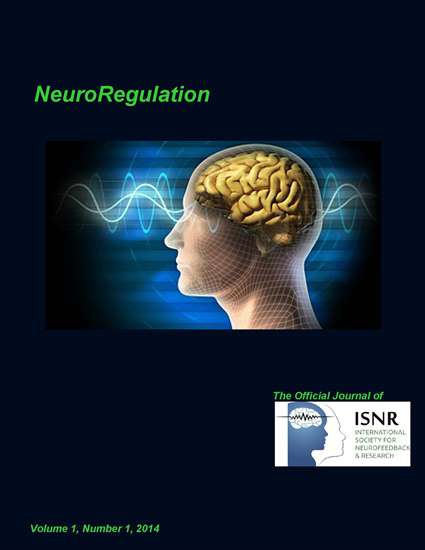Editorial - Volume 1, Number 1
DOI:
https://doi.org/10.15540/nr.1.1.2Abstract
It is a great honour and a privilege to welcome you to the inaugural edition of NeuroRegulation. NeuroRegulation represents an exciting new direction for the scientific and publishing arm of the International Society for Neurofeedback & Research. With the end of the Journal of Neurtherapy, an opportunity existed to totally re-evaluate the needs of members of the society and of the scientific community at large. To this end a decision was made to move from a traditional hard copy format to an electronic journal. This trend across all academic fields is now making the latest scientific advances in all fields available to everyone, not just those who are members of a society or have access to a tertiary education library. Electronic journals have also increased the speed at which knowledge is disseminated. In the past, the ‘latest research’ could actually be anything up to two years or more older before it was made available to the wider community. Electronic journals have seen this timeframe dramatically cut, which can only be good for any scientific endeavour. In relation to our field, this can only be seen as a good step. Clinicians are constantly looking for the latest knowledge and development in treatment options and an open access format will facilitate this. There are also many clinicians globally who do not have access to this information in hard copy. Now all they need is access to the internet to stay abreast of advances within the field.
One aspect of the journal that is quite novel for an open access journal, is there is no submission fee to authors. Most open access journal’s charge the author to publish rather than the reader to access the journal. This is due to the generous sponsorship provided by the International Society for Neurofeedback & Research and Mount Mercy University who are hosting the journal. What this means is that there is an opportunity for many of our readers to publish without cost, something that has stopped many from publishing in the past. To this end I encourage our readership to consider publishing if they think they have an idea or data that will add to our body of knowledge. If you are a clinician and have had success with a certain protocol, then please consider a submission. Even if it is a single case study, it may be ideal for placement in the clinical corner section of the journal. Remember, many great advances in science start from a single observation or a decision to try something different.
In this edition of the journal we have a pair of strongly worded companion papers from Dr Pigott and Dr Cannon discussing two claims about the level of existing evidence for Neurofeedback treatment of Attention-Deficit/Hyperactivity Disorder. Do you agree with their position or do you disagree? I welcome letters to the editor on these issues and encourage debate over the claims from both sides of the argument. In our Special Features section also we have a third paper from Dr Krigbaum and Dr Wigton discussing whether modality matters in Neurofeedback. In addition to these papers we have three research papers. The first is reporting the results of a study directed at developing a sham condition for use in high-definition transcranial direct current stimulation research. The problem of developing appropriate control conditions is very pertinent to new research as funding bodies are no longer happy to support simple wait list control trials and are asking for more sophisticated protocols that allow blinding to be carried out within the study. The second research paper by Dr Larson and colleagues investigated practitioner related factors that are associated with treatment adherence. This is a very important area of research and of particular interest to our readers in clinical practice. The final research paper by Dr Thornton and Dr Carmody investigated the Coordinated Allocation of Resource model using a recalling names of faces task. This interesting study identified specific changes in the EEG, which may have future relevance for enhancing cognitive performance in a number of clinical and subclinical populations. The final submission in the edition of the journal is a book review by Dr Lyle of the book ‘Neurotherapy and Neurofeedback: Brain-based Treatment for Psychological and Behavioral Problem’.
Thank you to all of those authors who have submitted to the inaugural edition of NeuroRegulation and I look forward to future submissions to the journal.
Adam R. Clarke
Senior Editor
Downloads
Issue
Section
License
Authors who publish with this journal agree to the following terms:- Authors retain copyright and grant the journal right of first publication with the work simultaneously licensed under a Creative Commons Attribution License (CC-BY) that allows others to share the work with an acknowledgement of the work's authorship and initial publication in this journal.
- Authors are able to enter into separate, additional contractual arrangements for the non-exclusive distribution of the journal's published version of the work (e.g., post it to an institutional repository or publish it in a book), with an acknowledgement of its initial publication in this journal.
- Authors are permitted and encouraged to post their work online (e.g., in institutional repositories or on their website) prior to and during the submission process, as it can lead to productive exchanges, as well as earlier and greater citation of published work (See The Effect of Open Access).











